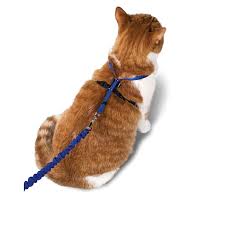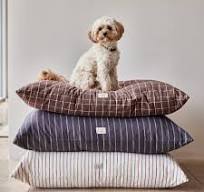The Benefits of Using a Cat Harness and Leash
Many cat owners may believe that harnesses and leashes are just for dogs, but in reality, they can be beneficial for cats too. Here are some reasons why using a cat harness and leash can be advantageous:
Exploration and Exercise
Cats are curious creatures by nature, and taking your feline friend for a walk with a harness and leash allows them to explore the outdoors safely. It provides mental stimulation and physical exercise, which is essential for their overall well-being.
Safety and Security
Unlike dogs, most cats are not trained to stay close to their owners when outside. A harness and leash ensure that your cat stays safe and secure while enjoying the fresh air. It prevents them from running off or getting into potentially dangerous situations.
Vet Visits
A harness and leash can make trips to the vet less stressful for both you and your cat. By getting your cat comfortable with wearing a harness early on, you can easily transport them in a carrier while being securely attached to you with the leash.
Bonding Time
Taking your cat for a walk on a harness and leash strengthens the bond between you and your pet. It creates opportunities for quality time together outdoors, where you can both enjoy each other’s company in a new environment.
Training Purposes
If you plan to travel with your cat or need to acclimate them to new surroundings, using a harness and leash is an excellent way to train them. It helps them get used to different environments while keeping them under your control.
Overall, investing in a cat harness and leash can provide numerous benefits for both you and your feline companion. Remember to choose a well-fitting harness designed specifically for cats to ensure their comfort and safety during outdoor adventures.
Top 9 FAQs About Using a Harness and Leash for Your Cat
- 1. How do I measure my cat for a harness?
- 2. What type of harness is best for a cat?
- 3. How do I get my cat used to wearing a harness?
- 4. Can all cats be trained to walk on a leash?
- 5. Are harnesses safe for cats?
- 6. How long can I leave a harness on my cat?
- 7. What should I consider when choosing a leash for my cat?
- 8. Can I use a dog harness on a cat?
- 9. Are there specific laws or regulations about walking cats on leashes in certain areas?
1. How do I measure my cat for a harness?
When measuring your cat for a harness, it is essential to ensure a proper fit for their comfort and safety. Start by measuring around your cat’s neck where a collar would typically sit. Then, measure around the widest part of their chest. Make sure the harness is snug but not too tight, allowing room for movement and breathing. It’s crucial to follow the manufacturer’s guidelines for sizing to select the appropriate harness size for your cat. By taking accurate measurements, you can ensure that your feline friend is comfortable and secure during outdoor adventures with their harness and leash.
2. What type of harness is best for a cat?
When considering the best type of harness for a cat, it is essential to prioritize comfort, safety, and ease of use. A harness specifically designed for cats, such as a figure-eight or H-style harness, is generally recommended as it provides a secure fit without restricting movement. Look for adjustable straps and soft materials that won’t chafe or cause discomfort to your feline friend. Additionally, opting for a harness with a secure closure mechanism, like buckles or snaps, can help prevent escapes while ensuring your cat’s safety during outdoor excursions. Always ensure proper fit and acclimate your cat gradually to wearing the harness for a positive experience.
3. How do I get my cat used to wearing a harness?
To help your cat get used to wearing a harness, it’s essential to introduce it gradually and positively. Start by placing the harness near your cat’s favorite resting spot so they can investigate it at their own pace. Then, slowly accustom them to the harness by letting them sniff and touch it while offering treats or praise to create a positive association. Once they seem comfortable with the harness, try putting it on for short periods indoors, allowing your cat to move freely while wearing it. Gradually increase the time they wear the harness before attempting to attach a leash. Patience and consistency are key when training your cat to accept wearing a harness.
4. Can all cats be trained to walk on a leash?
Training a cat to walk on a leash is possible for many cats, but not all felines may take to it easily. While some cats may adapt quickly and enjoy exploring outside on a harness and leash, others may be more resistant or fearful of the unfamiliar experience. Patience, positive reinforcement, and gradual training are key when attempting to teach a cat to walk on a leash. It’s important to respect your cat’s individual personality and comfort level throughout the training process, as not all cats will exhibit the same level of interest or willingness to walk on a leash. With time and persistence, many cats can learn to walk on a leash safely and enjoy the outdoor experience with their owners.
5. Are harnesses safe for cats?
When it comes to the safety of harnesses for cats, it is essential to choose the right type of harness and ensure a proper fit. While some cats may initially resist wearing a harness, with patience and training, most cats can adapt to wearing one comfortably. Harnesses designed specifically for cats are equipped with features that prevent escape and provide a secure fit without restricting their movement. It is crucial to supervise your cat while they are wearing a harness and leash to ensure their safety and prevent any accidents. By following proper guidelines and selecting a suitable harness, you can safely enjoy outdoor adventures with your feline friend.
6. How long can I leave a harness on my cat?
When it comes to leaving a harness on your cat, it is important to prioritize your feline friend’s comfort and safety. While some cats may tolerate wearing a harness for longer periods, it is generally recommended to supervise your cat closely when they are wearing a harness. Avoid leaving the harness on for extended periods, especially when unsupervised, to prevent any potential discomfort or hazards. Regularly check the fit of the harness and ensure that it is not causing any irritation or restriction of movement for your cat. Remember that each cat is unique, so observe their behavior and adjust accordingly to ensure a positive experience with their harness.
7. What should I consider when choosing a leash for my cat?
When considering a leash for your cat, there are several important factors to keep in mind. Firstly, opt for a lightweight and durable material that is comfortable for your cat to wear. Look for a leash that is adjustable to ensure a proper fit without being too tight or too loose. Consider the length of the leash as well, making sure it provides enough freedom for your cat to explore while still keeping them safe and under control. Additionally, choose a leash with secure fastenings and reliable hardware to prevent any accidental escapes. Prioritize safety and comfort when selecting a leash for your feline companion to make outdoor adventures enjoyable for both of you.
8. Can I use a dog harness on a cat?
It is not recommended to use a dog harness on a cat. Dog harnesses are designed differently from cat harnesses, taking into account the unique anatomy and behavior of each animal. Cat harnesses are typically lighter, more secure, and have specific features to ensure the comfort and safety of a feline companion. Using a dog harness on a cat may not provide the proper fit, leading to discomfort or potential escape. It is advisable to choose a harness specifically designed for cats to ensure their well-being during outdoor activities.
9. Are there specific laws or regulations about walking cats on leashes in certain areas?
It is essential for cat owners to be aware of any specific laws or regulations regarding walking cats on leashes in certain areas. While many places allow cats to be walked on leashes, some cities or neighborhoods may have restrictions or guidelines in place. It is advisable to check with local authorities or animal control agencies to ensure compliance with any relevant laws or regulations before taking your cat out for a walk. Being informed about the rules can help ensure the safety of your cat and maintain harmony within the community.




